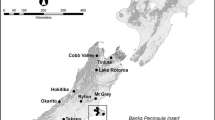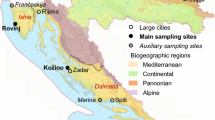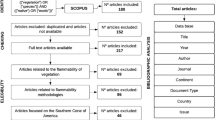Abstract
The susceptibility of Juniperus communities to prescribed fires can vary greatly throughout the year. The objective of this project was to determine the relationship between the seasonal concentration and composition of volatile oils and plant flammability in two Ashe juniper (Juniperus ashei) populations. Total monoterpenoid concentration was significantly affected by season and by plant population. Mean monoterpenoid concentration of a population from each central Texas was 9.16 mg/g fresh weight of juniper needles while the mean concentration of a west central Texas population was 11.62 mg/g of fresh weight. Monoterpenoid concentrations were typically lowest during the summer and highest during the spring and winter in the western population, but there was no seasonal pattern in the eastern population. The eastern population of trees was slightly (4.8%) more flammable than the western population, and male trees were slightly (3.8%) more flammable than female trees. The concentration of limonene was positively related to plant flammability and could increase flammability by 30% over the range of cencentrations found in this species. Bornyl acetate was negatively related to flammability with each 1 mg/g increase in concentration resulting in a 2% decrease in flammability. Caloric energy content and percent leaf moisture were not significant factors in determining the percentage of the Ashe juniper plant actually burned. Secondary chemicals, usually considered as antiherbivore mechanisms, may also serve an important role in determining the likelihood of a plant being consumed by fire.
Similar content being viewed by others
REFERENCES
Adams, R. P. 1970. Seasonal variation of terpenoid constituents in natural populations of Juniperus pinchotii Sudw. Phytochemistry 9:397–402.
Adams, R. P. 1977. Chemosystematics—analysis of populational differentiation and variability of ancestral and recent populations of Juniperus ashei. Ann. M. Bot. Gard. 64:184–209.
Adams, R. P. 1987. Yields and seasonal variation of phytochemicals from Juniperus species of the United States. Biomass 12:129–139.
Adams R. P. 1994. Geographic variation and systematics of monospermous Juniperus (Cupressaceae) from the Chihuahua Desert based on RAPDs and terpenes. Biochem. Syst. Ecol. 22:699–710.
Adams, R. P., and Turner, B. L. 1970. Chemosystematic and numerical studies of natural populations of Juniperus ashei Buch. Taxonomy 19:728–751.
Adams, R. P., Zanoni, T. A., and Hogge, L. 1984. Analyses of the volatile leaf oils of Juniperus deppeana and its infraspecific taxa: Chemosystematic implications. Biochem. Syst. Ecol. 12:23–27.
Bond, W. J., and Midgley, J. J. 1995. Kill thy neighbour: An individualistic argument for the evolution of flammability. Oikos 73:79–85.
Bryant, F. C., Launchbaugh, G. K., and Koerth, B. H. 1983. Controlling mature Ashe juniper in Texas with crown fires. J. Range Manage. 36:165–168.
Cool, L. G., Power, A. B., and Zavarin, E. 1991. Variability of foliage terpenes of Fitzroya cupressoides. Biochem. Syst. Ecol. 19:421–432.
Duncan, A. J., Hartley, S. E., and Iason, G. R. 1994. The effect of monoterpene concentrations in Sitka spruce (Picea sitchensis) on the browsing behaviour of red deer (Cervus elaphus). Can. J. Zool. 72:1715–1720.
Foster, J. H. 1917. The spread of timbered areas in central Texas. J. For. 15:442–445.
Fulhendorf, S. D., Smeins, F. E., and Grant, W. E. 1996. Simulation of a fire–sensitive ecological threshold: A case study of Ashe juniper on the Edwards Plateau of Texas, USA. Ecol. Model. 90:245–255.
Gambliel, H. A., and Cates, R. G. 1995. Terpene changes due to maturation and canopy level in Douglas fir (Pseudotsuga menziesii) flush needle oil. Biochem. Syst. Ecol. 5:469–476.
Gilmore, A. R. 1977. Effects of soil moisture stress on monoterpenes in loblolly pine. J. Chem. Ecol. 3:667–676.
Hall, G. D., and Langenheim, J. H. 1986. Within–tree spatial variation in the leaf monoterpenes of Sequoia sempervirens. Biochem. Syst. Ecol. 14:625–632.
Halls, S. C., Gang, D. R., and Weber, D. J. 1994. Seasonal variation in volatile secondary compounds of Chrysothamnus nauseosus (Pallas) Britt.; Asteraceae ssp. hololeucus (Gray) Hall. & Clem. influences herbivory. J. Chem. Ecol. 20:2055–2063.
Kainulainen, P., Oksanen, J., Palomaki, V., Holopainen, J. K., and Holopainen, T. 1992. Effect of drought and waterlogging stress on needle monoterpenes of Picea abies. Can. J. Bot. 70:1613–1616.
Klepzig, K. D., Kruger, E. L., Smalley, E. B., and Raffa, K. F. 1995. Effects of biotic and abiotic stress on induced accumulation of terpenes and phenolics in red pines inoculated with bark beetle–vectored fungus. J. Chem. Ecol. 21:601–626.
Maarse, H., and Kepner, R. E. 1970. Changes in composition of volatile terpenes in Douglas fir needles during maturation. J. Agric. Food Chem. 18:1095–1101.
Mihaliak, C. A., and Lincoln, D. E. 1985. Growth pattern and carbon allocation to volatile leaf terpenes under nitrogen–limiting conditions in Heterotheca subaxillaris (Asteraceae). Oecologia 66:423–426.
Montgomery, K. R. 1976. Ether extractives and flammability of Mediterranean–type shrubs. MS thesis. California State Polytechnic University, Pomona, p38.
Muzika, R. M., Pregitzer, K. S., and Hanover, J. W. 1989. Changes in terpene production following nitrogen fertilization of grand fir [Abies grandis (Dougl.) Lindl.] seedlings. Oecologia 80:485–489.
Nerg, A., Kainulainen, P., Vuorinen, M., and Hanson, M. 1994. Seasonal and geographical variation of terpenes, resin acids and total phenolics in nursery grown seedlings of Scots pine (Pinus sylvestris L.). New Phytol. 128:703–713.
Owens, M. K. 1996. The role of leaf and canopy–level gas exchange in the replacement of Quercus virginiana (Fagaceae) by Juniperus ashei (Cupressaceae) in semiarid savannas. Am. J. Bot. 83:617–623.
Owens, M. K., and Schliesing, T. G. 1995. Invasive potential of ashe juniper after mechanical disturbance. J. Range Manage. 48:503–507.
Owens, M. K., and Schreiber, M. C. 1992. Seasonal gas exchange characteristices of two evergreen trees in a semiarid environment. Photosynthetica 26:389–398.
Owens, M. K., Straka, E. J., Carroll, C. J., and Taylor, C. A., Jr. 1998. Technical note: A comparison of techniques for extracting monoterpenoids from Juniperus (Cupressaceae) species. J. Range Mange. 51:540–544.
Philpot, C. W. 1969. Seasonal changes in heat content and ether extractive content of chamise. USDA Forest Service Research Paper INT 61:Int–61.
Raffa, K. F., and Smalley, E. B. 1995. Interaction of pre–attack and induced monoterpene concentrations in host conifer defense against bark beetle–fungal complexes. Oecologia 102:285–295.
Reineke, R. K. 1996. Ashe juniper seed production and germination, seedling dynamics and response of liveoak/juniper mottes to summer fire. MS thesis. Texas A&M University. College Station, Texas, 111 pp.
Riddle, R. R., Taylor, C. A., Jr., Kothmann, M. M., and Huston, J. E. 1996. Volatile oil contents of Ashe and redberry juniper and its relationship to preference by Angora and Spanish goats. J. Range Manage. 49:35–41.
RodrÍguez AÑÓn, J. A., Lopez, F. F., Castineiras, J. P., Ledo, J. P., and Nunez, Regueira, L. 1995. Calorific values and flammability for forest wastes during the seasons of the year. Bioresource Technol. 52:269–274.
Scholander, P. F., Hammel, H. T., Bradstreet, E. D., and Hemmingsen, E. A. 1965. Sap pressure in vascular plants. Science 148:339–346.
Smeins, F. E. 1980. Natural role of fire on the Edwards Plateau, pp. 4–16, in L. D. White (ed.). Prescribed Burning on the Edwards Plateau of Texas. Texas Agricultural Extension Service, College Station, Texas.
Troumbis, A. Y., and Trabaud, L. 1989. Some questions about flammability in fire ecology. Oecologia 10:167–175.
Wagner, M. R., Clancy, K. M., and Tinus, R. W. 1990. Seasonal patterns in the allelochemicals of Pseudotsuga menziesii, Picea engelmannii and Abies concolor. Biochem. Syst. Ecol. 18:215–220.
Welch, B. L., and McArthur, E. D. 1981. Variation of monoterpenoid content among subspecies and accessions of Artemisia tridentata grown in a uniform garden. J. Range Manage. 34:380–384.
White, C. S. 1994. Monoterpenes—their effects on ecosystem nutrient cycling. J. Chem. Ecol. 20:1381–1406.
Wright, H. A., and Bailey, A. W. 1982. Fire Ecology: United States and Southern Canada. John Wiley & Sons, New York.
Zedler, P. H. 1995. Are some plants born to burn? Trends Ecol. Evol. 10:393–395.
Zou, J. P., and Cates, R. G. 1995. Foliage constituents of Douglas fir (Pseudotsuga menziesii (Mirb) Franco (Pinaceae)—their seasonal resistance and silviculture management. J. Chem. Ecol. 21:387–402.
Author information
Authors and Affiliations
Rights and permissions
About this article
Cite this article
Owens, M.K., Lin, CD., Taylor, C.A. et al. Seasonal Patterns of Plant Flammability and Monoterpenoid Content in Juniperus ashei . J Chem Ecol 24, 2115–2129 (1998). https://doi.org/10.1023/A:1020793811615
Issue Date:
DOI: https://doi.org/10.1023/A:1020793811615




